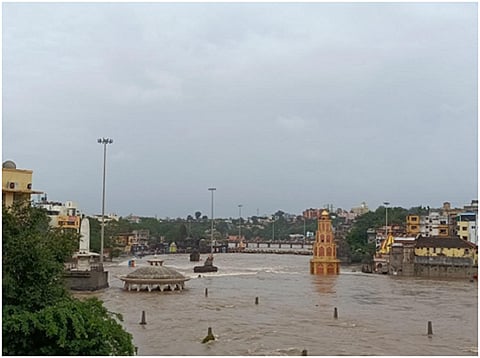In the name of development: How Nashik’s Goda Ghat juggled concretisation & de-concretisation over 2 decades
The July 2022 floods at Goda Ghat, Nashik exposed the impacts of trying to tame the Godavari river in the name of riverfront development.
Goda Ghat got shaped and re-shaped in the last two decades by state interventions, particularly through urban-missions and schemes. These include the Jawaharlal Nehru National Urban Renewal Mission (JNNURM), Atal Mission for Rejuvenation and Urban Transformation (AMRUT) and Smart City Mission (SCM) as well as the Kumbh Melas.
Timeline of major interventions at Goda Ghat
The 1992 Kumbh mela was a watershed moment for the Godavari in Nashik. This is when concretisation commenced in and along Goda Ghat to mend the potholes and slippery nature of the basalt bedrock.
A decade later, ahead of the 2003 Kumbh Mela, a massive re-concretisation of the banks took place for beautification and to prevent drowning. This extensive concretisation not only destroyed the riverine ecology but also blocked 17 kunds (structures to store water) with four natural springs.
It resulted in reduced width of the river, changing its natural hydraulic flow. This caused lateral erosions and flooding in the surrounding areas.
The Godavari riverfront development initiative was brought under JNNURM, with stormwater drainage as important components of the city development plan. The project was politically motivated in the line of the Sabarmati riverfront development.
The Rs 60 crore first phase of the Godavari riverfront development included construction of a concrete walkway (2.5 kilometres). However, this colossal project did not succeed because of the concretisation-driven massive flooding incident in 2008 — considered one of the worst floods in the city.
The mission and scheme of infrastructural development also failed to bring significant relief to the city. The city, for instance, spent approximately Rs 400 crores to install 300 kilometres of drainage under JNNURM and construction of sewerage treatment plants under AMRUT.
But none of the projects turned out to be beneficial for the city. It is because no separated stormwater and sewerage drainage were installed and the planners overlooked the natural surface geomorphology of the city. This resulted in worse incidents of waterlogging and sporadic flooding.
Interestingly, the sewerage infrastructure in the core city is discharging within 500 metres of the sacred Ram Kund and has been polluting the poised ghat.
In 2013, the riverfront development was handed over to the Reliance India Foundation because of fund constraints. The company began to develop a nearly 500 m stretch of the Goda Park in 2014.
Re-concretisation and redevelopment of the ghat was carried out once again on the eve of the 2015 Kumbh Mela. The repercussions of the concretisation were evident in the 2016 pre-monsoon droughts, when the river dried up and exposed the concrete riverbed.
Later, in the monsoon period, the city also experienced destructive floods. Local experts claimed that, along with heavy rains, the concretisation of the riverbed and confluence of the major sewerage system around the Goda Ghat were the main reasons.
‘Smart’ riverfront development
The consequences of unsustainable infrastructure development practices inevitably pushed environmentally conscious citizens to the Bombay High Court for the rejuvenation of the river.
Nashik was also selected under SCM and the riverfront infrastructure development featured as the identity of the city in the SCM proposal. The project was envisioned as an opportunity to generate revenue.
It specifically proposed to redevelop the Godavari riverfront with promenade, boating and beautification of the Goda Ghat to attract more tourists.
NMSCDCL de-concretised only four out of 17 kunds between Dutondya Maruti to Gadge Maharaj Bridge, for fulfilling the court mandate.
Besides this ‘symbolic’ de-concretisation, in the ambitious Goda Park project (on the other side of the Ahilyabai Holkar Bridge), both horizontal and vertical concretisation is going on.
As one of the residents of Nashik puts it, “Call it smart or stupid, they are just concretising it.”
Indubitably, these interventions represent the techno-managerial unsustainable patchwork which is not apt for the health of the river and will further aggravate the future flooding events.
Rather than injecting funds for short-term patchworks, there is a need to develop flood-resilient long-term strategy with the stakeholder engagements. The central schemes such as JNNURM, AMRUT and SCM have failed to address the complexities of disasters.
These missions and schemes have also failed to acknowledge the diversities of Indian cities and provided a universal template of urban development.
Hence, the disaster-resilient city-specific infrastructure is yet to be part of the discourse. Therefore, there is an urgent requirement to integrate disaster management and climate change with long-term planning for resilient urban futures.
In a nutshell, the installation of precarious infrastructure along the ghat and the booming real-estate along the river require critical attention for rectification.
The future of the Godavari in Nashik needs to count on the interaction of riverine ecology, religious identity, shifting land-use and unimagined impact of climate change.
Views expressed are the author’s own and don’t necessarily reflect those of Down To Earth.


